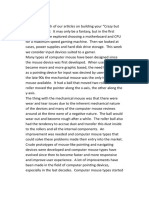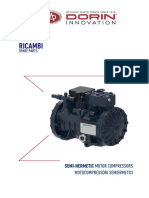Computer Mouse Specifications and
Types
1. General Overview of the Computer Mouse
Introduction
- The computer mouse is an input device used to interact with a computer's graphical
interface.
- It typically consists of two buttons (left and right) and a scroll wheel.
Functionality
- The mouse moves a cursor on the screen to select, drag, or manipulate objects.
- It sends signals to the computer based on movement and button clicks.
2. Types of Computer Mice
Wired Mouse
- Connected to the computer through a USB or PS/2 cable.
- Offers stable, lag-free performance but restricts movement.
Wireless Mouse
- Operates through radio frequency (RF) or Bluetooth technology.
- Provides more freedom of movement but may require batteries or charging.
Gaming Mouse
- Designed with precision, customizability, and extra buttons for gaming.
- Features like DPI adjustment, high polling rate, and customizable macros.
Ergonomic Mouse
- Designed to reduce strain and improve comfort during long use sessions.
- Often has a unique shape or vertical design to encourage a more natural hand position.
Trackball Mouse
- A mouse where the ball is rotated instead of moving the entire device.
�- Great for precision in small spaces, but may require an adjustment period.
Pen-Style Mouse
- Shaped like a pen and used for drawing or detailed work, often for digital art.
3. Mouse Technologies
Mechanical Mouse (Ball Mouse)
- The original type of mouse, which uses a rubber ball to detect movement on a surface.
- It can get dirty and require cleaning due to the ball's contact with the surface.
Optical Mouse
- Uses an optical sensor to detect movement over a surface.
- More precise and durable than mechanical mice, and does not require a mouse pad.
Laser Mouse
- Uses a laser for detecting movement, allowing higher precision and better performance on
a wider range of surfaces.
- Often used in gaming and professional environments where precision is crucial.
Capacitive and Touch Mice
- Capacitive sensors detect electrical signals from the user's finger.
- Touch mice can perform gestures, such as swiping and scrolling, with multi-touch support.
Wireless Technology
- RF (Radio Frequency) and Bluetooth technologies enable wireless mice to connect to
computers.
- Bluetooth mice don't require a USB receiver, while RF mice need a receiver plugged into
the computer.
4. Mouse Customization and Features
DPI Adjustment
- DPI (Dots Per Inch) determines the sensitivity of the mouse.
- Higher DPI offers faster movements on screen, useful for gaming or design work.
Polling Rate
�- The polling rate determines how often the mouse updates its position to the computer.
- Measured in Hz, higher polling rates result in smoother and more responsive performance.
Programmable Buttons
- Gaming and professional mice often come with extra programmable buttons.
- These can be customized for specific actions, macros, or shortcuts.
RGB Lighting
- Many mice come with customizable RGB lighting for aesthetics or to indicate status.
Ergonomics and Design
- Mice are designed for comfort with various shapes and materials to reduce fatigue and
strain.
- Ergonomic mice are particularly designed for users with repetitive strain injuries (RSI).
5. Mouse Maintenance and Care
Cleaning the Mouse
- Regular cleaning of the mouse, especially the sensors and buttons, helps maintain its
performance.
- Use a microfiber cloth and gentle cleaning solutions to avoid damage.
Maintaining Battery Life (for Wireless Mice)
- Recharge or replace the batteries regularly to ensure optimal performance.
- Consider turning off the mouse when not in use to conserve battery life.
Surface Considerations
- Use a mouse pad to improve tracking precision and reduce wear on the mouse sensor.
- For laser mice, using hard or smooth surfaces may yield better results than soft or uneven
ones.























































































